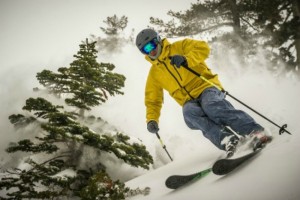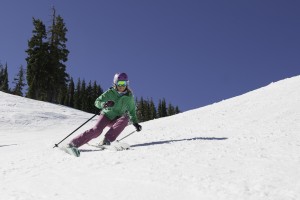Golfers who regularly hit their drive long and straight don’t do it by accident. Basketball players who methodically make free throw after free throw aren’t lucky. And tennis players with perfect ground strokes that can be repeated over and over again didn’t come by the skill naturally.
What the big hitter in golf, the high percentage free-throw shooter and the skilled tennis player have in common is knowledge and perseverance. All three have worked hard to perfect their craft, diligently working long hours at their particular sport.

Those same qualities also can be found in expert skiers. No one successfully masters a double black diamond run without possessing solid technique and putting in the time it requires to master more difficult terrain.
To ski extreme terrain, one needs to build confidence over time. One of the main things to remember is patience. Don’t gaze down at an advanced run and say, “I think I’ll try that today.” Build confidence over time and avoid taking unnecessary chances.
“How does one get to Carnegie Hall? The same way they get to black diamond runs or even double black diamond areas. (It takes) practice, practice, practice,” said Allen Zalkind, a Sierra-at-Tahoe instructor with 35 years of experience. “Days on skis need to be long and frequent. If time is limited you can still greatly improve by just getting on the snow and practicing.”
What many people overlook is taking a lesson. Skiers frequently take a lesson when they start out, so why not take a lesson when trying to make the ascent from good to expect? Learning without an instructor can be accomplished if patience and practice are part of the formula. Sugar Bowl ski instructor Dan Salem says trial and error is a suitable method as long as it is done with safety in mind.
“It makes me cringe every time I see someone going down an advanced run out of control or doing the radical stuff that they see in ski and snowboard films,” Salem said. “They are being reckless and endangering not only themselves, but other people as well.”
A ski instructor for more than three decades at Sugar Bowl, Salem says entering an expert run at mid-level is one way to ease into tougher terrain. That not only decreases the speed factor, but reduces the number of turns that will need to be executed before getting to the bottom.
“You want to build up to where you are doing the entire run,” Salem said.
Another method is practicing the proper technique – skis are parallel and turns can be quickly executed at fairly high speed – on easier runs first instead of expert trails. That helps build confidence, which can be a fragile thing on a difficult run, especially for people who are going at high speed with limited control.

Confidence is an important factor in progressing to an elite level. Skiers need to be focused on what they are supposed to be doing, not thinking about how intimidating the run might be. Zalkind says pole usage is another factor in making the jump from a good to great skier.
“Poles are an important part of skiing. As we become stronger skiers, poles play an increasingly more important role,” Zalkind said. “We use poles for balance, blocking, sensory, pushing, up-weighting, deflection, timing and myriad of other practices. Certainly poles are not as important as skis, and skis are not as important as boots, but expert skiers do not overlook any of these equipment topics.”
To reach that elite level faster, Zalkind recommends taking a group or private lesson, which can be the safest and quickest method to progress.
“Skiing is one of those sports that is difficult to figure out on your own,” Zalkind said. “It is a bit counter intuitive, similar to golf. Lessons will definitely help a skier make that leap to faster, steeper and more challenging runs much quicker.”
Jeffrey Weidel can be reached at [email protected]. Follow him on Twitter @jeffweidel and visit his website at www.tahoeskiworld.com.